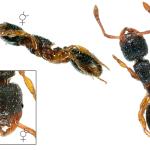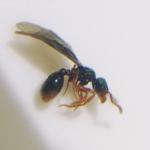Workers of this dark coloured, slow moving species are seldom seen in the open. When disturbed, the female castes curl into balls and appear dead. Blacker & Collingwood (2002) provide a useful commentary on this ant based on their Wiltshire records.
In Britain, Myrmecina graminicola occurs throughout southern England, and just into the Midlands. There are a few records from south and west Wales. It occurs on the Scilly Isles and on the Channel Islands, but is not known from Ireland. Elsewhere, M. graminicola is present throughout Europe as far north as southern Sweden and east at least to the Caucasus. It also occurs in north-west Africa (Collingwood 1979; Czechowski et al. 2002). The possibility that records from southern parts of the Russian Far East and Korea refer to a closely related species cannot be ruled out (Czechowski et al. 2002).
Neither Shirt (1987) nor Falk (1991) list M. graminicola as scarce or threatened in Britain.
Myrmecina graminicola nests in cliffs, in pasture, and in dry open woodland. There are recent records of workers taken from grassland in a London park (Jones 2004) and from private gardens. Nests may be found under stones or pieces of fallen wood, in dead tree stumps, in soil, or under moss. Workers and small colonies have also been found in the nests of other ant species (Donisthorpe 1927; Bolton & Collingwood 1975).
Sexuals develop during late summer. The mating period extends from August to October, with mating taking place on the ground (Bolton & Collingwood 1975; Collingwood 1979; Blacker & Collingwood 2002; Buschinger 2003). The winged females exhibit sexual calling behaviour by depositing a sex pheromone, produced in the poison gland, on the ground (Buschinger 2003).
Nests typically have fewer than 100 workers (Seifert 1996; Buschinger & Schreiber 2002; Czechowski et al. 2002). Each has either a single egg- laying queen, a single, mated egg-laying intercaste (a female intermediate in form between a worker and a queen), or several mated egg-laying intercastes (Buschinger & Schreiber 2002).
Workers forage on the ground and in litter, scavenging and preying on small invertebrates. They do not tend aphids (Czechowski et al 2002).
2006



